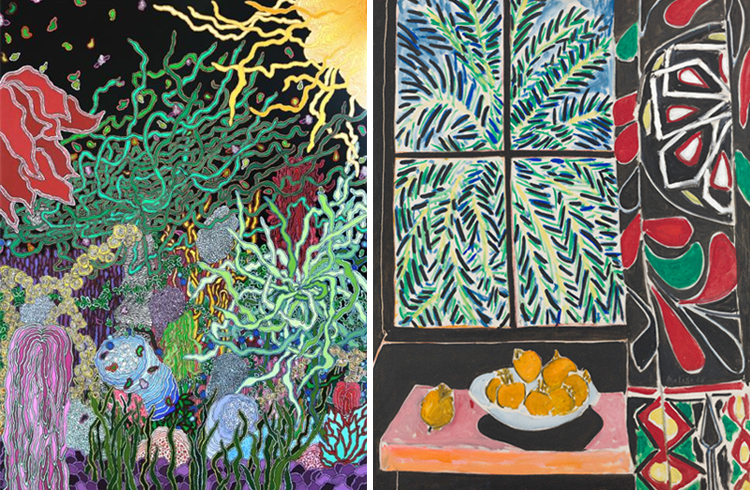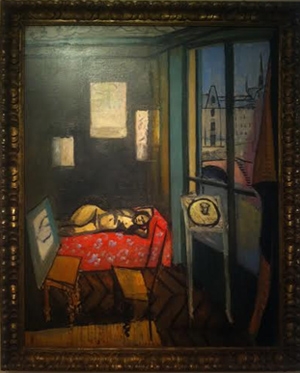Hear from Phillips Curator Klaus Ottmann how contemporary artist Carol Brown Goldberg’s work echos that of Henri Matisse’s Interior with Egyptian Curtain in the One-on-One installation currently on view.
Hear from Phillips Curator Klaus Ottmann how contemporary artist Carol Brown Goldberg’s work echos that of Henri Matisse’s Interior with Egyptian Curtain in the One-on-One installation currently on view.

(1) Carol Brown Goldberg, Maggie on My Mind, 2015 (2) Matisse, Henri, Interior with Egyptian Curtain, 1948, Oil on canvas Framed: 48 5/8 in x 38 1/4 in x 2 in; 123.52 cm x 97.15 cm x 2 in; 45 3/4 x 35 1/8 in.; 116.205 x 89.2175 cm.. Acquired 1950; © 2015 Succession H. Matisse/ Artists Rights Society (ARS), New York
How does one converse with a piece of art? Can it talk back? What does it have to say? These are the questions at the heart of The Phillips Collection’s One-on-One series, which engages artists to select a work from the museum’s permanent collection and juxtapose it with works of their own. DC-based artist Carol Brown Goldberg uses Henri Matisse’s Interior with Egyptian Curtain as a source of inspiration for her current body of work. But how does one go about creating a conversation between your own work and that of a master like Matisse? She states of this exhibition, “Matisse’s Interior with Egyptian Curtain encompasses the world of the sublime, the ecstatic—an almost supernatural world of color, competition, and pattern. It is not just a world of pleasure, but one that allows tension and harmony to exist simultaneously. This ambiguity of forces, perhaps a reflection of our internal world, is an inspiration for endless gardens.” So how exactly does she respond to this idea in visual terms?
It is rare that a work by Matisse is described as restrained or limited, but this is how it appears in comparison to Goldberg’s works as she expands upon the idea of Matisse as creator of a world of pattern and color. Interior with Egyptian Curtain sets the stage with the establishment of a color palette and loose, expressionistic forms. Matisse’s window gives the viewer just a glimpse of the world outside, a world of lush greenery and exoticism. It beckons, almost drags the viewer in to see more of this wild and free space, and this is where Goldberg takes over. She takes Matisse’s cue, and explodes his tease into a world where intense color and expression reign supreme. The colors are bold and match the wild, swirling forms that spread beyond the edges of the canvas, enveloping the viewer and pulling us further and further into this “supernatural world of color, competition, and pattern.” Goldberg seems to create the world that Matisse alludes to and envisions, a world in which anything and everything goes.
Allyson Hitte, Marketing & Communications Intern

Henri Matisse, Studio, Quai Saint-Michel, 1916. Oil on canvas, 58 1/4 x 46 in. The Phillips Collection, Washington, DC, Acquired 1940.
What is it like to be an artist working at The Phillips Collection? I tackle this question not because I claim to be an artist—far from it, in fact; I see myself more as a cultural sociologist than an artist—but because over the last month or so of working here, I have been inspired to create more than ever before. More to the point, over the next few weeks, the Phillips is exhibiting works by artists employed at the museum and I wanted to take a moment to think about how we are all affected by working amongst great art.
It is a traditionally held dictate that visitors to a museum shall passively engage with the art. Walk up to it silently, contemplate subject and color for a moment, then move on to the next piece. Here at the Phillips, however, the environment is such that one cannot help but become intimately attached to the works hanging on the walls. They become old friends, and we move from passive engagement to something more ambiguous and often awkwardly articulated. The works of art become inspiration. They pop up in dreams and motifs in our own work. Moreover, most of the museum guards have an artistic bent which allows for conversation about and active engagement with the art, and who among us does not feel a tinge of joy when we come across the many troops of school children discussing pieces and creating their own art in response? Personally, I have become obsessed with Henri Matisse’s Studio, Quai Saint-Michel. It is currently on view on the second floor of the original Phillips house in a small gallery just past Renoir’s Luncheon of the Booting Party. The painting’s size in this room makes it imposing and all consuming. It is as if you are transported into that studio space with its soft light. It has sparked in my work a new interest in color and pattern, as well as an impulse to incorporate other art forms such as music into my otherwise purely visual creations.
It is impossible to remain passive in a museum like the Phillips. You are constantly confronting works in a personal way and they in turn intimately confront you. Being an artist working here is like gaining the ability of osmosis as the creative urge seeps into your veins. All I can say is, after a day’s work within this museum, I cannot wait to get back to my canvas and paints.
Dominique Lopes, Director’s Office Intern